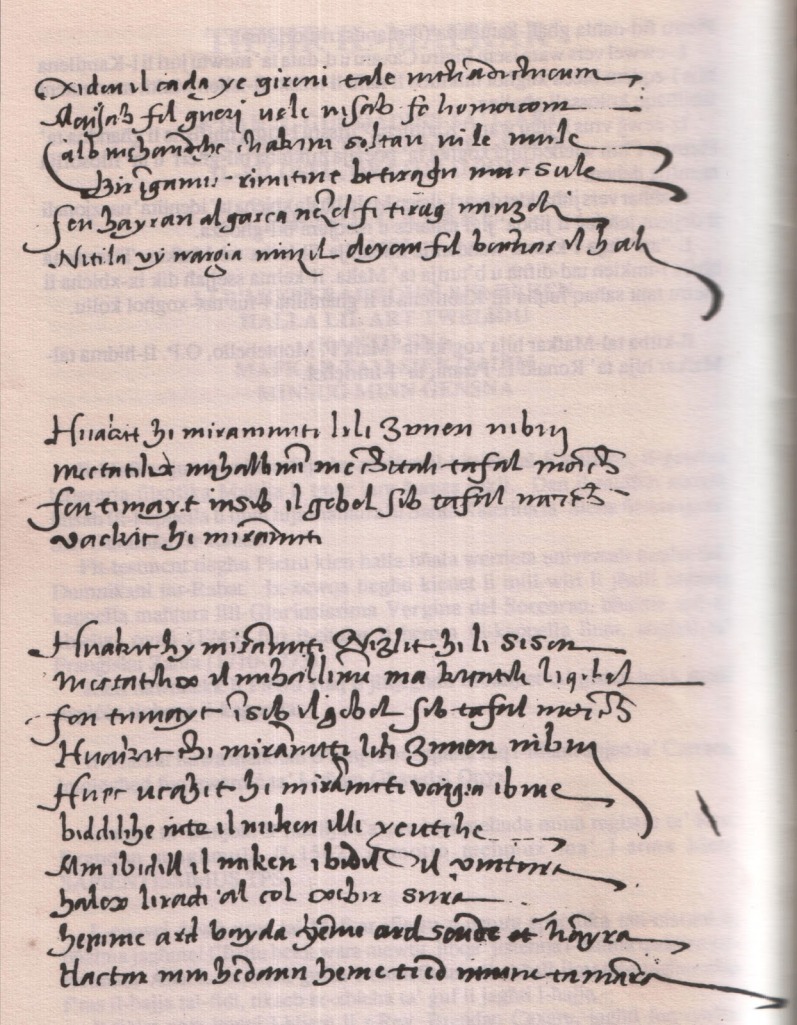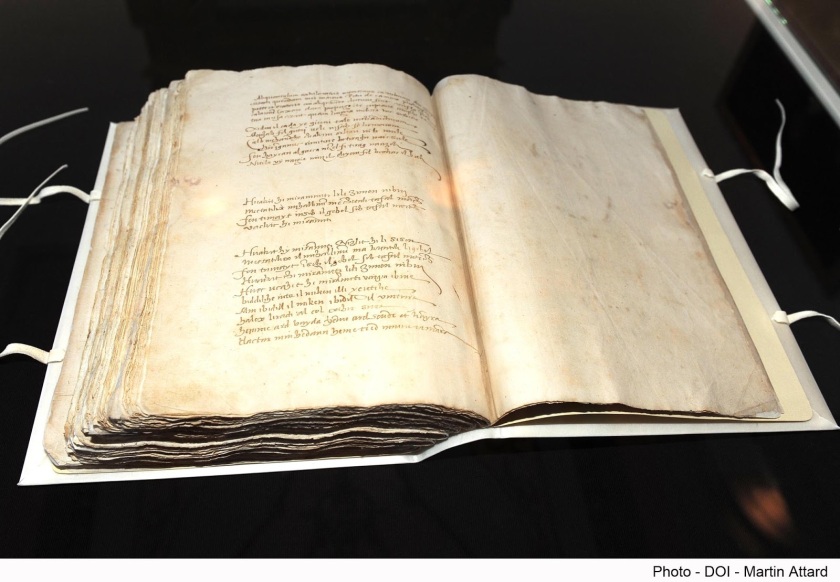“Il Cantilena” is the oldest known literary text in the Maltese language. It dates from the 15th century (no later than 1485, the death of its author, and probably from the 1470s) but was not found until 1966 or 1968 by Prof. Godfrey Wettinger and Fr. Fsadni (OP).
“Il Cantilena” is a poem attributed to one Petrus (Pietrus, Pietro, Pietru, or Peter) Caxaro. It was recorded by Caxaro’s nephew, Brandano, in his notarial register (Dec. 1533 — May 1563).
Text
Original orthography
This is the text of the Cantilena in the original orthography:
Xideu il cada ye gireni tale nichadithicum
Mensab fil gueri uele nisab fo homorcom
Calb mehandihe chakim soltan ui le mule
Bir imgamic rimitne betiragin mucsule
Fen hayran al garca nenzel fi tirag minzeli
Nitla vu nargia ninzil deyem fil bachar il hali.
Huakit hi mirammiti lili zimen nibni
Mectatilix mihallimin me chitali tafal morchi
fen timayt insib il gebel sib tafal morchi
vackit hi mirammiti.
Huakit by mirammiti Nizlit hi li sisen
Mectatilix li mihallimin ma kitatili li gebel
fen tumayt insib il gebel sib tafal morchi
Huakit thi mirammiti lili zimen nibni
Huec ucakit hi mirammiti vargia ibnie
biddilihe inte il miken illi yeutihe
Min ibidill il miken ibidil i vintura
haliex liradi ’ al col xibir sura
hemme ard bayad v hemme ard seude et hamyra
Hactar min hedann heme tred mine tamara.
Modern orthography
Maltese orthography was not standardised until the 20th century; there were many variant spelling conventions in texts written before this time.
In modern orthography, the text would be:
Xidew il-qada, ja ġirieni, tale nħadditkom,
Ma nsab fil-weri u la nsab f’għomorkom
Qalb m’għandha ħakem, sultan u la mula
Bir imgħ ammiq irmietni, b’ turġien muħ sula,
Fejn ħ ajran għ all-għ arqa, ninż el f’ taraġ minżeli
Nitla’ u nerġa’ ninżel dejjem fil-baħar il-għoli.
Waqgħet hi, imrammti, l’ ili żmien nibni,
Ma ħtatlix mgħallmin, ’ mma qatagħ li tafal merħi;
Fejn tmajt insib il-ġebel, sibt tafal merħi;
Waqgħet hi, imrammti.
Waqgħet hi, imrammti, niżżlet hi s-sisien,
Ma ħ tatlix l-imgħallmin, ’ mma qatagħ li l-ġebel;
Fejn tmajt insib il-ġebel, sibt tafal merħi;
Waqgħet hi, imrammti, l’ ili żmien nibni.
U hekk waqgħet hi, imrammti! w erġa’ ibniha!
Biddilha inti l-imkien illi jewtiha;
Min ibiddel l-imkien ibiddel il-vintura;
Għaliex l-iradigħ al kull xiber sura:
Hemm art bajda, w hemm art sewda u ħamra.
Aktar minn hedawn hemm trid minnha tmarra.
An approximate English translation
Witness my predicament, my friends (neighbours), as I shall relate it to you:
never has there been, neither in the past, nor in your lifetime,
A [similar] heart, ungoverned, without lord or king (sultan),
That threw me down a well, with broken stairs
Where, yearning to drown, I descend the steps of my downfall,
Climb back up, only to go down again in this sea of woe.
It(she) fell, my edifice, [that] which I had been building for so long,
It was not the builders’ fault, but (of) the soft clay (that lay beneath);
Where I had hoped to find rock, I found loose clay
It(she) fell, my building!
It(she) fell, my building, its foundations collapsed;
It was not the builders’ fault, but the rock gave way,
Where I had hoped to find rock, I found loose clay
It (she) fell, my edifice, (that) which I had been building for so long,
And so, my edifice subsided, and I shall have to build it up again,
change the site that caused its downfall
Who changes his place, changes his “vintura”!
for each (piece of land) has its own shape (features);
there is white land and there is black land, and red
But above all, you must stay clear of it.
The Cantilena read in Medieval Maltese with medieval and contemporary subtitles:


I’m currently working on a fresh interpretation of the Cantilena.
Roderick Bovingdon
Excellent
A very good attempt at this 500 year old reading.
Roderick